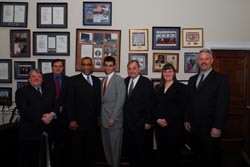- If there is one thing liberals and conservatives can agree on, it's that government doesn't work quickly. Unfortunately for us in the entertainment industry, there is important legislation being talked about now that actually requires the issue to be resolved by 2009, and this is not one that can be rushed.
Shown with Rep. Shelley Berkley (D-NV, fourth from left) are (l-r) Shure's Mark Brunner and Jeff Krull, Mark Dennis (Cirque du Soleil), Bill Evans (FOH magazine), and Scott Harmala (ATK Audiotek), all of whom are members of the Microphone Interests Coalition.
Currently wireless microphone technology mostly exists on VHF frequencies between 174Mhz and 216Mhz, and on the UHF band between 470Mhz and 806Mhz. These are considered "white spaces" within the current analog TV spectrum, or in other words, the spaces between channels. If the Wireless Innovation Act of 2007 passes as it is now written, then the frequencies on which wireless mics operate will be opened up to interference from an array of unlicensed devices (UD). To complicate things further, in an attempt to stop interference between multiple UDs, many of these products will be operating on multiple frequencies simultaneously to ensure a constant connection. Wireless microphone signals are low-powered, usually 50mW, and are not continuous, which makes then considerably more difficult to detect by these "hopping" UDs.
Microphone manufacturers and groups such as the Professional Audio Manufacturers Alliance (PAMA) have filed with the FCC asking for more "time to fully test and then implement a policy that restricts harmful interference from consumer devices without disrupting the public and broadcast events that today's wireless products serve."
UD proponents say that interference concerns will be addressed by spectrum sensing devices developed by the manufacturers, but microphone industry lobbying groups have posed a solution which sets aside specific frequencies for their operation, and they are asking UD manufacturers to "prove conclusively that spectrum sensing works effectively in real world conditions." However, the cries of our industry may never be heard over the roar of interest the telecommunications industry has shown over this legislation.
Mark Brunner, senior director of public relations at Shure Incorporated, answered a few questions concerning the future of wireless microphones:
SCN: If the current legislation passes as it is written now, what's the next step in wireless microphone development to combat the interference problems that will arise?
MB: The difficulty with these bills for wireless manufacturers is the lack of specificity regarding actual frequency ranges that would be affected and the operating characteristics of the new devices. This is why Shure has lobbied to allow the FCC proper time to test new unlicensed devices and to determine a workable allocation of the RF spectrum. Future system designs will likely focus on flexibility and adaptability to help users navigate crowded RF environments. Once final rules are written, manufacturers will produce products that operate in the frequency ranges that have lowest potential for interference.

Industry reps in Washington for the White Spaces cause (l-r): Richard Fitzgerald, Sound Associates; Bob Rendon, PRG Audio; Rep. Bobby L. Rush (D-IL); Geoff Shearing, Masque Sound; Paul Gallo, PAMA; Danielle Burt, Bingham McCutchen; Jeff Krull, Shure Inc.
MB: Certainly healthy R&D budgets are helpful in addressing transitions in technical markets. However, innovation is not the privilege of the large. In fact, smaller companies often benefit from a sharp focus on product and technology issues that have the potential to greatly impact their business. Also, as wireless audio becomes more ubiquitous, the smaller firms will see new opportunities to address niche markets that have highly specific needs and cost models. The future landscape of wireless professional audio will be shaped by the innovations of both the large and small players, as it has been to date.
SCN: Would you agree that the first company to come up with a viable solution to this problem has the opportunity to gain huge market share?
